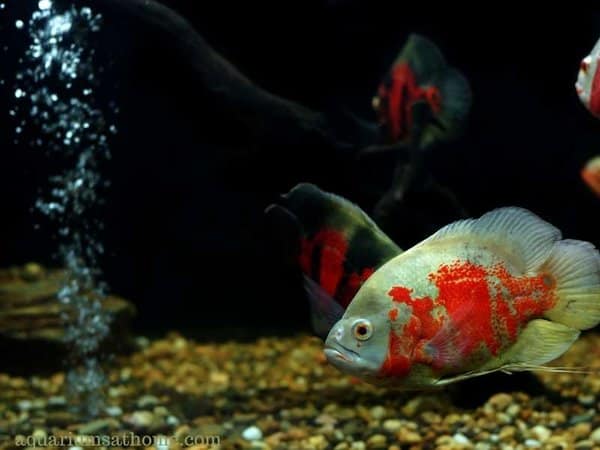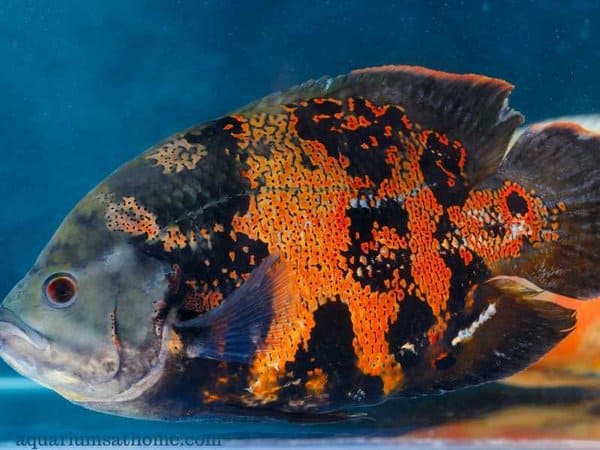Oscars (also known as marble cichlids, velvet cichlids, or tiger cichlids) are a large species of tropical freshwater fish that require specific aquatic conditions not only to survive, but to thrive in captivity. As an aquarist, you may be wondering how to setup an Oscar tank that best mimics their natural habitat?
Oscar fish need an extra-large tank with an aquatic environment reminiscent of the Amazon River. An adjustable light and a heater are required along with a high-quality, powered filter and an air pump. A fine gravel or sand substrate with water plants, rocks, and other hiding places are also recommended.
Now that you know what size tank and types of equipment are needed for Oscar fish, let’s ‘dive deeper’ into this topic. Together we’ll discover what kind of substrate is best; which plants are recommended; what temperature and pH are required; if they need salt in their water; why an air pump is necessary; and which fish make the best tankmates.
So, if your interest is piqued and you want to learn more about setting up an Oscar fish tank, then please read onward…
What Size Tank is Best for Oscar Fish?
Oscars are very large by aquarium fish standards. They can reach adult lengths of up to 14 inches and need an extra-large tank to thrive in captivity. A 75-gallon tank is recommended for just a single Oscar with an additional 25-gallons for each additional fish.
Do Oscar Fish Need Gravel or Sand?
In terms of substrate for an Oscar fish tank, you can use either gravel or sand. Oscars are intelligent and will ‘redesign’ their environment to suit their liking. They’ll typically move substrate around by picking it up in their mouths and then spitting out in a different spot.
Please note that if you use sand as substrate in an Oscar tank, then you should install a pre-filter on the filtration system’s intake to prevent fine particles from entering the filter and clogging it up.
Instead, opt for finely crushed gravel which also provides a better foundation for aquatic plants.
Do Oscar Fish Need a Light?
Oscar fish do require an aquarium light in their tank. This helps them to find food easier and better navigate their surroundings. That said, they shouldn’t be kept in direct sunlight and prefer a dimly lit environment. Choose an LED bulb with an adjustable brightness option and/or a blue light feature.
Do Oscar Fish Need Salt?
Oscars are a type of freshwater fish and such, don’t require salt in their tank. A small amount of salt (1 teaspoon per 5 gallons) can be added to help control parasites such as ‘ich’ and promote the Oscar’s ability to produce a protective slime coating.
Do Oscar Fish Need an Aerated Tank?
Oscar fish are native to the fast-moving waters of the Amazon River. As such, they need an air pump or stone in their tank to help aerate the water and create a stronger current. If you choose not to install an air pump, then you should add live plants to boost oxygen levels in their aquatic environment.

Do Oscar Fish Need a Heater?
Oscars are a type of tropical freshwater fish and therefore require a heated tank. A temperature of 74- to 81-degrees Fahrenheit is needed to keep the aquatic environment safe and conducive to that in the wild.
A 375-watt heater is required to keep the water warm and at 10 degrees above room temperature.
Do Oscar Fish Need a Filter?
Oscar fish are very large! They can reach full-grown lengths of 14 inches in the wild and at least a foot long in captivity. Being so big, they eat a lot and create a lot of waste. Hence, they require an electrically powered filter such as a hang-on-back style to keep the water both clean, clear, and ammonia-free.
As well, Oscar fish originate in the fast-moving waters of the Amazon River. Therefore, a good filtration system will help not only to aerate the water, but to create current-like movement. In addition to a high-powered filter, consider adding an air pump and/or air stone to improve the health of your Oscars.
Steps to Setting Up an Oscar Fish Tank
To setup an Oscar fish tank, simply follow the 10 steps outlined below:
- Begin with a clean, sterilized, extra-large aquarium – 75-gallons or bigger, depending on how many fish you have.
- Wash and disinfect all tank decorations in advance to kill any lingering bacteria and prevent it from contaminating your aquarium.
- Carefully place an under-gravel filter on the bottom of the tank if that’s your filter of choice.
- Add 3-5 inches of fine gravel or sand substrate evenly along the base.
- Half-fill the tank with room-temperature, pre-conditioned water – use Aquatic Experts Tap Water Conditioner from Amazon.
- Place rocks, plants, and other ornaments into the tank carefully to avoid disturbing the substrate – don’t add too many decorations and be aware of objects with sharp edges.
- Add a hang-on-back filter and aquarium heater to the tank.
- Continue to fill the tank with room-temperature, pre-conditioned water.
- Place a lid with an attached LED aquarium light on top – Oscars are excellent jumpers so they must be contained.
- Test the water parameters – if the temperature (from 74- to 81-degrees Fahrenheit) and pH (between 6 and 8) are accurate, then begin introducing fish to the tank.
Do Oscar Fish Need Hiding Places?
Hiding places are a great way to reduce stress in an Oscar fish tank. This species is both aggressive and territorial. Providing coverage by way of plants, rocks, caves, etc. will help keep your Oscars peaceful and promote breeding, if that’s what you intend to do in the future.
Can Oscar Fish be Kept in a Planted Tank?
Oscar fish can be kept in a planted tank, provided the plants are thick and have strong roots. Oscars are notorious for ‘rearranging’ their aquatic environment – this includes moving substrate, knocking over decorations, and uprooting plants. Instead, opt for floating plants such as salvinia natans (floating moss).
What Tankmates are Best for Oscar Fish?
The best tankmates for Oscar fish are other Oscars. This species prefers the company of their own kind and do well in mated pairs or small groups of 5 or 6. Don’t keep Oscars in 3’s as two will likely pair up and bully the odd one out!
If a community tank environment with Oscars is what you’re after, then consider tankmates of like size and temperament. Other species of South American cichlid such as convicts, firemouths, green terrors, parrots, jaguars, and jewels make good companions as well as silver dollars and red-tailed sharks.
You can also keep Oscar fish with large, peaceful bottom-dwellers like bichirs, loaches, and plecos. These fish reside mainly along the substrate and tend to stay out of the way of Oscars, which prefer to swim in the hop half of the tank.
Do Oscar Fish Grow to the Size of the Tank?
Contrary to popular belief, aquarium fish don’t grow to fit the size of their tank. How big a fish gets is determined mainly by genetics and the quality of food it receives. A too-small or overcrowded aquarium typically increases stress for fish which can result in stunted growth.

Final Thoughts
To summarize, Oscar fish require an aquatic environment reminiscent of their natural habitat – the Amazon River. An extra-large tank is needed along with an aquarium light, heater, filter, and air pump.
Fine gravel substrate with water plants and other decorations for coverage are also recommended.
I trust this article has been of help and provided the information you need on how to setup an Oscar fish tank. Thanks for reading and good luck with your aquarist hobby!
Recommended Posts
Oscar Fish Essential Care Guide
Best Tank Size for Oscar Fish (55, 65, 75, 90 or 125 Gallons?)
Can Oscar Fish be Used in Aquaponics?
Do Oscar Fish Eat their Babies?
How to Breed Oscar Fish in an Aquarium
Why Do Oscar Fish Open Their Mouths Wide?




